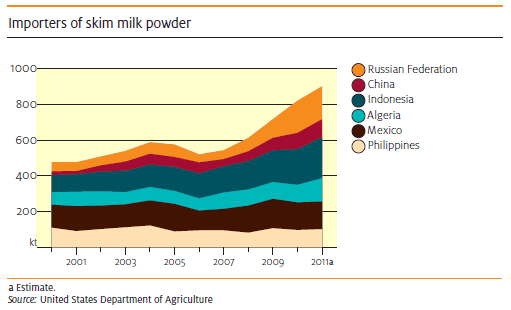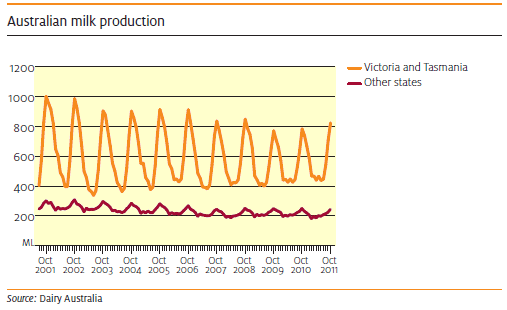



Agricultural Commodities: Dairy
World prices for most dairy products are forecast to average lower in 2011–12, according to the Australian Bureau of Agricultural and Resource Economics (ABARE) December Agricultural Commodities report.
World prices for most dairy products are forecast to average lower in 2011–12. Prices for butter and whole milk powder are forecast to decline by 10 per cent and 5 per cent, respectively, to average US$4200 a tonne and US$3600 a tonne in 2011–12. Prices for both cheese and skim milk powder are forecast to fall by 1 per cent to average US$4190 a tonne and US$3350 a tonne, respectively. Such dairy price outcomes for 2011–12 would still be around 12 per cent to 20 per cent above the 2009–10 average prices.
World dairy product prices fell between 2 per cent and 9 per cent during the first four months of 2011–12, reflecting a softening in global dairy demand and increased supplies of dairy products from the major producing and exporting countries.
Over the remainder of 2011–12, world prices for most dairy products are expected to be supported by continuing, but slower, growth in dairy demand in Asia, the oil exporting countries of North Africa and the Middle East, and the Russian Federation. However, forecast slower economic activity in the European Union in 2012 is expected to dampen European demand for dairy products, particularly cheese.

Global supplies to remain high
Despite an expected slowdown in the growth of global milk production in the second half of 2011–12, the supply of dairy products is forecast to remain high in the major producing and exporting countries.
European Union
While EU milk production increased year-on-year by 1.8 per cent in the first six months of the 2011–12 marketing year (April to March) the growth in milk output is forecast to slow in many EU member countries in the second half of the year. This slowdown can be attributed to an expected small reduction in the EU dairy herd and forecast continuing high feed grain prices.
Despite a 1 per cent increase in the milk quota for the 2011–12 marketing year, total EU production is expected to remain below the quota. However, given the strong rise in milk output in France and Ireland in the first half of the 2011–12 marketing year, farmers in those two countries may limit milk deliveries in the second half of the year in order to remain within their respective quotas.
While EU cheese production is forecast to increase in 2011–12, weaker growth in EU demand for cheese is likely to increase the quantity of cheese available for export.
United States
Despite high feed grain prices and continued slaughtering of dairy cows, the US dairy herd expanded in the second half of 2011, reflecting the large number of heifers entering the herd. As a result, US milk production is forecast to increase by 1.6 per cent in 2011.

The growth in US milk production is expected to slow in 2012, with output forecast to rise by 1.3 per cent to 90 million tonnes. Forecast continuing high feed grain prices and lower farmgate milk prices are expected to reduce profitability in the US dairy sector in 2012, limiting gains in milk yields. Furthermore, lower profitability is expected to result in farmers increasing their culling of dairy cows, which would lead to a contraction in the national herd. The forecast higher milk production in the United States in 2012 is expected to be diverted into the manufacture of butter, cheese and skim milk powder. With only modest gains expected in US domestic dairy consumption, there is likely to be increased availability of these products for export in 2012, particularly skim milk powder and cheese. In 2011, US exports of skim milk powder are estimated to have risen significantly. It is expected that skim milk powder exports will increase again in 2012, providing strong competition to other exporters, such as Australia and New Zealand, especially in Asian markets.
New Zealand
New Zealand milk production is forecast to rise by around 5 per cent in the 2011–12 marketing year (June to May) to 18.8 million tonnes, as producers respond to relatively high milk prices and favourable seasonal conditions, particularly in the first half of the 2011–12 marketing year. Dairy cow and heifer numbers are estimated to have increased year-on-year by around 3 per cent to 4.68 million as at June 2011. Most of this increase is expected to have occurred on the South Island where additional farms have entered the dairy industry. Assuming average seasonal conditions for the remainder of 2011–12, average milk yields are forecast to rise by around 2 per cent for the year as a whole.
South America
With higher domestic milk production during 2011, Argentina significantly increased its production and exports of whole milk powder and cheese. Assuming average seasonal conditions, Argentina is forecast to produce a similar volume of milk in 2012 and to export around 200 000 tonnes of whole milk powder. A greater share of exports is forecast to be shipped to Brazil where demand for dairy products is expected to remain strong and domestic production is expected to increase slightly.
World trade supported by firm demand
An assumed slowing in economic growth in developing countries through the remainder of 2011–12 is not expected to significantly affect global trade in dairy products. Import demand for dairy products by the Russian Federation, Asia, the Middle East and North Africa is likely to remain firm.
Chinese imports of whole milk powder increased year-on-year by 16 per cent in the first eight months of 2011, although a year-on-year easing was observed between July and October 2011. Chinese imports of milk powders are forecast to remain strong in the remainder of 2011–12. Consumer concerns over the safety of domestically produced milk powders, due to detection of melamine, led to sustained strong demand for imported product. Overall, Chinese imports of whole milk powder are forecast to increase by around 14 per cent in 2012 to 450 000 tonnes.
The Russian Federation is the world’s largest export market for cheese and butter, importing an estimated 315 000 tonnes of cheese and 135 000 tonnes of butter in 2011. Increased supplies of domestic grain and fodder are expected to lead to an increase in milk production in 2012. However, production of cheese and butter is forecast to decline as the forecast additional milk supplies are expected to be used for fluid milk and production of milk powders. Consequently, cheese and butter imports by the Russian Federation are forecast to remain firm in 2012.
Following a reduction in domestic production, Japan more than trebled its butter imports to around 13 000 tonnes in the first six months of the 2011–12 marketing year (April to March) compared with the same period in 2010–11, while imports of cheese rose by around 9 per cent over the same period. Despite weak income growth assumed in the short term, demand for dairy products in Japan is forecast to remain relatively firm.
Elsewhere in Asia, import demand for dairy products is expected to remain firm over the remainder of 2011–12. Reflecting strong growth in domestic demand and concerns about domestic supplies, the Indian Government increased the import quota for skim milk powder (subject to a zero tariff rate) from 30 000 tonnes in 2010–11 (April to March) to 50 000 tonnes in 2011–12. Indonesia, a major market for skim milk powder, is forecast to increase its imports of milk powders in 2012 following an expansion in milk recombining plants in 2011.

Australian milk production
Australian average farmgate milk prices are forecast to decline by 4 per cent in 2011–12 to 41.5 cents a litre, reflecting the compounding effect of forecast lower world dairy prices and an assumed relatively strong Australian dollar.
After a slow start in July and August 2011, Australian milk production increased by 6.4 per cent in September 2011 as a result of improved pasture growth in the dairy regions of south-eastern Australia. Victorian milk production was 8 per cent higher year-on-year in September 2011, with particularly strong increases in the northern and western regions. Milk production in the northern dairying areas of Victoria increased by 11.4 per cent in the first quarter of 2011–12 compared with the same period last year.
Assuming average seasonal conditions over the remainder of 2011–12, Australian milk production is forecast to increase by 3 per cent to 9.35 billion litres. Nearly all the increase in production is expected to occur in Victoria, southern New South Wales and Tasmania. Farmers have increased the size of their herds, with dairy cow numbers increasing by 0.5 per cent to over 1.6 million head as at June 2011. The significant improvement in water availability for irrigation in northern Victoria and southern New South Wales is expected to underpin the forecast increase in milk production in these areas, which are recovering from the effects of below average seasonal conditions over the past few years. The favourable seasonal conditions are expected to result in many dairy farmers replenishing on-farm storage of hay and silage.
Australian production of cheese and whole milk powder is forecast to rise by around 3 per cent in 2011–12 to 350 000 tonnes and 156 000 tonnes, respectively, reflecting higher returns relative to other dairy products.

Australian consumption
Australian consumption of market milk is forecast to rise by around 2 per cent in 2011–12 to around 2.4 million litres. Consumption of market milk increased year-onyear by 2.7 per cent in the first three months of 2011–12.
The price discounting of home brand milk by major supermarkets since late January 2011 continued to affect market milk sales. Between February and September 2011, the share of home brand milk sold through supermarkets increased by 5 percentage points to 54 per cent while branded milk sales declined by 5 percentage points to 46 per cent.
Australian dairy export earnings to fall
The value of Australian dairy exports is forecast to fall by around 3 per cent in 2011–12 to around $2.27 billion following a 12.4 per cent increase in 2010–11. The forecast decline mainly reflects lower world prices and the continued effect of an assumed strong Australian dollar.

December 2011
| TheCattleSite News Desk |


